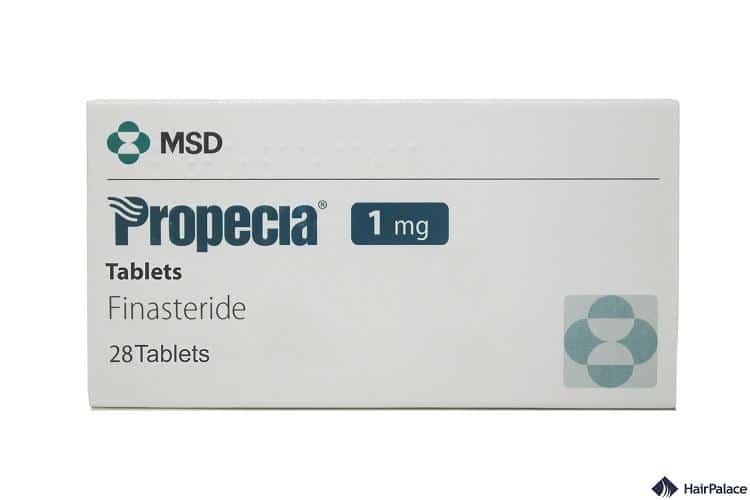Does Diabetes Cause Hair Loss? Causes and Treatments

Diabetes affects around 4.9 million people in the UK, while approximately 850,000 of those living with it have yet to be diagnosed.
It is a chronic health condition where the body either doesn’t produce enough insulin or doesn’t use insulin effectively, leading to high blood sugar levels.
Persistent high blood sugar can cause various complications, including cardiovascular disease, nerve damage, kidney disease, vision problems, and even hair loss.
But why does diabetes cause hair to fall out, and will hair loss from diabetes grow back?
This post will cover the common types of diabetes, how they can cause hair loss, and what treatment options are available.
Diabetes and hair loss: Fast facts
| Type of hair loss | Diffuse thinning, Alopecia areata |
| Is body hair affected? | Yes |
| Is it reversible? | Yes, in some cases |
| Who is affected? | Men and Women |
| Treatment options | Biotin, Minoxidil, Lifestyle changes |
What is diabetes?

Diabetes is a medical condition that prevents the body from producing a healthy amount of insulin, a natural hormone created by the pancreas.
The body lacks the insulin required to move the glucose, or the insulin produced cannot perform its function.

Diabetes hair loss
Diabetes can cause hair thinning and hair loss in some people as it can have the following effects on the growth cycle of the hair:
- impairing hair growth
- causing more hair to grow than normal
- stopping new hair from forming
Several different factors may cause a person with diabetes to lose hair, but the most common causes include those below.

Hyperglycemia
Hyperglycemia (high blood sugar) happens when sugar isn’t taken into cells for energy and instead remains in the blood flow.
This may occur as a result of a lack of insulin, insulin resistance, or both.
The excess sugar can lead to damaged blood vessels if the issue persists for a prolonged period.
This can also restrict blood flow below the knees, which may damage hair follicles on the leg.
The decreased blood flow also leads to less oxygen and nutrients for the hair follicles, and as a result, the normal growth cycle of hair gets disrupted.
Improper blood sugar control can cause poor circulation and vascular impairment.
Hyperglycemia may also cause hair thinning, fragile hair, and decreased hair growth speed.
Insulin resistance can result in microvascular impairment, which has a role in the pathophysiology of androgenetic alopecia.
A 2019 study found that black women are at a higher risk of central scalp hair loss due to type 2 diabetes.
The research concluded that black women with type 2 diabetes hair loss should be monitored closely to identify the issue and administer the appropriate treatment in time.
Thyroid Issues

People with diabetes should have their thyroid levels checked at least once per year.
Thyroid disease is especially common in patients with type 1 diabetes hair loss.
Hypo- or hyperthyroid disease can lead to significant hair thinning.
Alopecia Areata
Diabetes and hair loss in men is a common occurrence.
People with type 1 diabetes have a higher likelihood of developing other autoimmune disorders.
The most common one is alopecia areata, which occurs due to the immune system attacking a person’s hair follicles. This can lead to patchy hair loss.
Alopecia areata can affect the entire body, leading to thinning hair on the scalp, eyebrows, eyelashes, or other areas of the body.
Hormones and stress
Diabetes can put a great deal of stress, both physical and emotional, on a person’s body.
Persistent stress can cause hormone fluctuations that can affect hair growth.
Is hair loss from diabetes reversible?
In most cases, the hair loss isn’t permanent. Diabetes management can be achieved in multiple ways, although treatment can differ for males and females.
Many people can slow or stop their hair loss.
One of the most effective ways is simply controlling the high blood sugar level and limiting emotional and physical stress.
Blood sugar management involves:
- Regularly monitoring a person’s blood sugar levels
- Taking all medications as instructed
- Having a balanced diet
- Exercising on a regular basis
Some of the best ways to manage stress are:
- Seeking support from friends and family
- Going to counselling
- Practicing meditation, yoga, or breathing techniques
How to treat diabetes hair loss – 7 treatment options
You should keep in mind that there is no universal diabetes and hair loss treatment that works for everyone.
Treatment options will largely depend on the cause of hair loss and the type of hair loss you’re experiencing.
Male and female pattern hair loss is treated differently than alopecia areata for example.
However, in most cases, hair growth returns to normal once the intervention is started.
1. Managing blood sugar levels
As we’ve already discussed elevated blood sugar levels can damage blood vessels, cause vascular disruption, and hormonal imbalances as well as lead to hair loss.
Therefore, maintaining your blood sugar levels within a normal range can prevent you from developing the signs of diabetes hair loss.
Generally speaking, blood sugars should be 80-130 mg/dL after not eating for at least 8 hours, and below 180 mg/dL two hours after eating.
However, these levels should be individualized with the help of a healthcare team. With their help you’ll be able to control both your blood sugar and hair loss.
2. Medication
Some medications are known to treat hair loss and lead to more hair growth.
The type of medicine you’re prescribed will depend on your age, your hair loss type, and the risks or side effects.
3. Corticosteroid creams or injections
Injections are primarily administered for adults, and they’re usually not recommended for children.
Creams may be applied to the areas affected by hair loss in both adults and children.
Injections usually make hair regrow for adults, while creams tend to be more effective for children.
4. Minoxidil (Rogaine)

Minoxidil stimulates growth by increasing the blood supply to each hair follicle.
It is available in topical or cream forms, and it’s supposed to be applied directly to the scalp daily.
However, the drug has several side effects, and you have to take minoxidil indefinitely if you want to maintain the results.
Regaine for Men Extra Strength Foam costs £35.95 on Amazon.
5. Anthralin
Another topical medication, which is often used in tandem with minoxidil. It works by slowing down the growth of skin cells.
Anthralin may cause skin irritation, skin soreness, and in more extreme cases, further hair loss.
6. Finasteride (Propecia)

Finasteride is a tablet used daily to treat enlarged prostates and male pattern baldness by decreasing DHT levels, leading to increased hair growth.
However, it can cause side effects such as erectile dysfunction, decreased libido, ejaculation disorder, and breast enlargement.
Women should avoid finasteride due to the risks of birth defects and reduced fertility.
A pack of 28 generic finasteride tablets costs £12.20 on Doctorfox.
7. Hair transplantation
A diabetes hair transplant may be an option if diabetes has disrupted your hair growth cycle.
Great care is critical, though, to ensure people affected by diabetes hair thinning remain safe and comfortable during hair transplants.
Blood sugar levels must be monitored closely.
HairPalace’s team offers in-depth consultations through Zoom, Facetime or WhatsApp.
This offers our experts an opportunity to assess your hair loss, discuss your health status, and determine if hair transplant surgery is the right option for you.
To learn more about our hair transplants, get in touch today!
Other effects of diabetes on the body
The symptoms of diabetes affect the body in several different ways, particularly if a person is unable to control their high blood sugar levels.
Some of the most common issues associated with diabetes include:
- Higher risk of stroke
- Increased risk of peripheral arterial disease
- Increased risk of heart disease
- Damage to the nerves
- Dry mouth
- Dry skin
- Having a higher risk of infection
Conclusion
Diabetes is a chronic condition that can have a wide range of effects on a person’s body.
In some people, diabetes can cause hair thinning or hair loss.
The primary causes of hair loss in people with diabetes are uncontrolled blood sugar levels, emotional and physical stress, and hormone imbalances.
Using medications and lifestyle interventions to get blood sugar levels under control may help reverse or slow down the effects of hair loss.
Some medications are also available as hair fall treatment for diabetics, although their effects may be short-lived.
Diabetes Hair Loss FAQ
In some people, diabetes can cause hair to fall out. The primary causes of hair loss in people with diabetes are uncontrolled blood sugar levels, emotional and physical stress, and hormone imbalances.
When your blood vessels get damaged, your body can’t properly transport oxygen and nutrients to your hair follicles, which can damage the hair growth cycle. The best way to avoid hair loss due to high blood sugar is to focus on eating a diet made up of foods with a low glycemic index.
Diabetes can also cause hair loss on the legs. Over time, diabetes-related damage to the blood vessels can result in peripheral artery disease (PAD). In PAD, a fatty deposit called plaque builds up in the blood vessels inside the legs. This interferes with blood flow and, consequently, hair growth
Insulin itself doesn’t directly cause hair loss, but underlying conditions like insulin resistance or poorly managed diabetes can affect hormone levels and blood flow to hair follicles, potentially leading to thinning hair or hair loss.
Hair transplants can be safe for diabetics if their blood sugar is well-controlled. However, healing may be slower, and there’s a slightly higher risk of infection or complications, so proper medical supervision is essential.
Last medically reviewed on March 21st, 2025
- Can diabetes affect your hair growth? (n.d.)https://beyondtype1.org/can-type-1-diabetes-affect-your-hair-growth/
- American Diabetes Association - Diabetes overview.https://www.diabetes.org/diabetes
- American Academy of Dermatology Association - Hair loss types: alopecia areata diagnosis and treatment.https://www.aad.org/public/diseases/hair-loss/types/alopecia/treatment
- Coogan PF, Bethea TN, Cozier YC, et al. Association of type 2 diabetes with central-scalp hair loss in a large cohort study of African American women. Int J Womens Dermatol. 2019;5(4):261-266. doi:10.1016/j.ijwd.2019.05.010https://doi.org/10.1016/j.ijwd.2019.05.010
- American Diabetes Association. 2. Classification and diagnosis of diabetes: Standards of medical care in diabetes—2022. Diabetes Care. 2022;45(Supplement 1):S17-S38. doi:10.2337/dc22-S002https://doi.org/10.2337/dc22-S002


